By Georgina Maddox
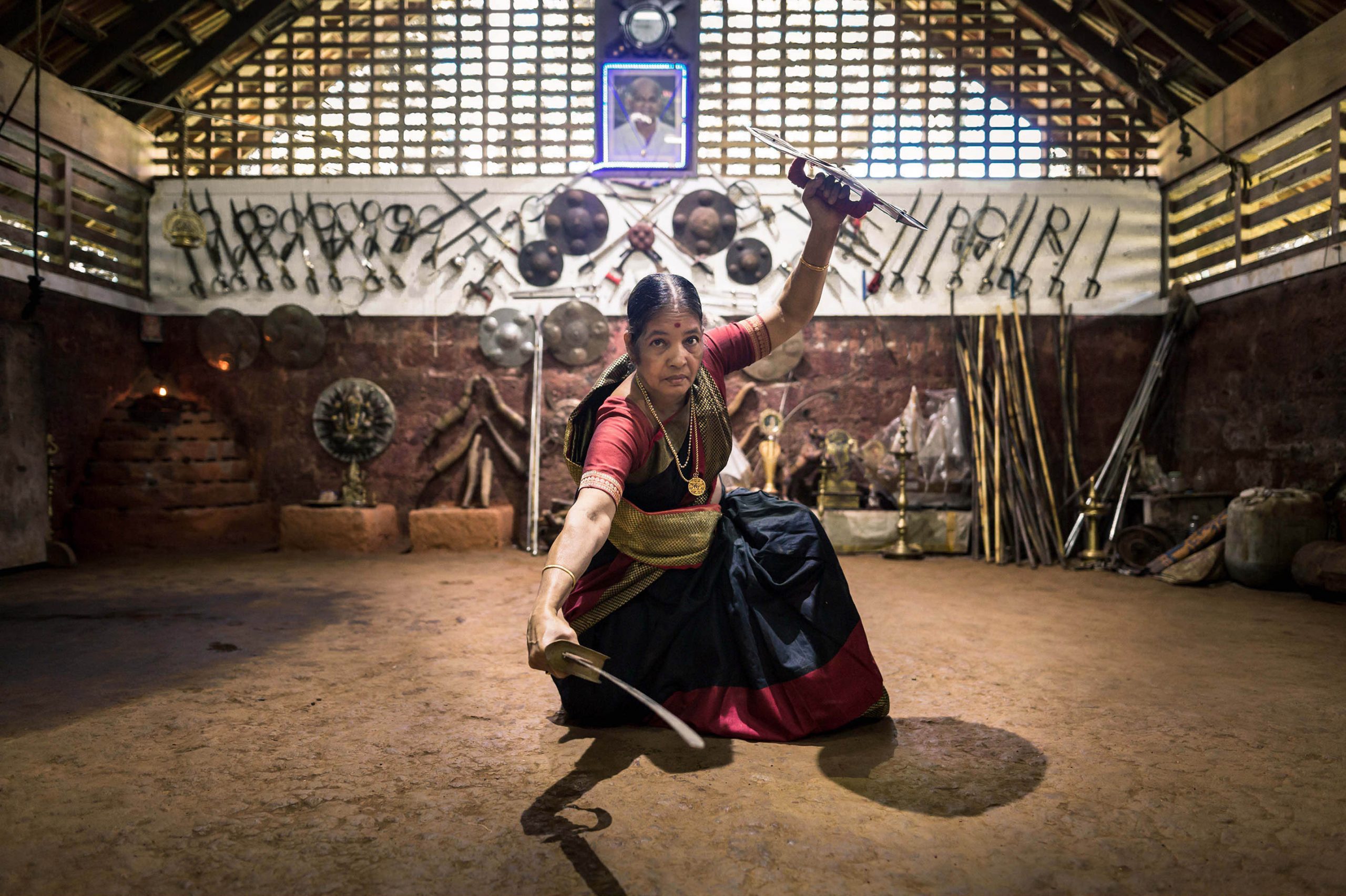
Playing football, skateboarding, wielding heavy machinery, or performing martial arts with swords have all traditionally been seen as male-dominated activities. Truth or Dare, presented at Studio Art in Okhla, New Delhi from 10 April – 10 June 2023, sought to challenge these notions by highlighting women who have sought to break the glass ceiling. For the exhibition, photographer and curator Sandeep Biswas brought together films and photographs made by women that put the spotlight on women from socially less-privileged groups that are active in these fields. Biswas wrote in his curatorial note, ‘Through the exhibition Truth or Dare, we put together visual stories by a few women photographers and filmmakers who have sensitively explored this changing world of women from various strata of life in India.’[1]
Biswas has been exploring gender as a social construct—as opposed to biological determinism—for quite some time now. From his previous online exhibition, A Diminishing Line (May–June 2022), which showcased the work of four women photographers,[2] he selected the work of two photographers — Paromita Chatterjee and Richa Bhavanam. Building on concepts of gender and performativity, he has also included the work of photographers Sahiba Chawdhary, Nadja Wohlleben and Puja Awasthi. The exhibition also featured documentary films by Sasha Rainbow and Anuradha Rana. Biswas has additionally used a selection of archival images from the women’s rights group, the Gulabi Gang. Sharing his curatorial process, Biswas reiterated how a show in physical space was different from an online one. He actively collaborated with gallerist Ashna Singh to put together the exhibition: ‘From the gallery, Ashna’s inputs on choice and her overall involvement made a big difference as she understood her space thoroughly and that gave us extreme clarity during the final execution.’ Biswas went on to add, ‘Once the works were finalized, the bigger challenge was the display.’
Kamali (2019) captures the struggles and dreams of its eponymous protagonist. In the short documentary made by BAFTA-nominated film director Sasha Rainbow, the little girl’s single mother fights for her empowerment through skateboarding, a conventionally male-dominated sport. Premiering in 2019, the film went on to win awards at the Atlanta and Raindance Film Festivals. The young girl is seen training as a skateboarder while also balancing expectations around ‘womanly’ duties. Kamali’s mother has consistently fought to protect her daughter’s right to try something different. Similarly, in the film Ring Laila (2011), the arena of boxing comes alive on the screen, as female athletes take a page out of gold medalist boxer Mary Kom’s book. Directed by Anuradha Rana, an independent filmmaker and educator based in Chicago who was born and raised in India, the work showcases gutsy women who train to be boxers. The characters fight against stereotypes as they push the boundaries of gender and class in an avowedly male sport [Fig. 2].
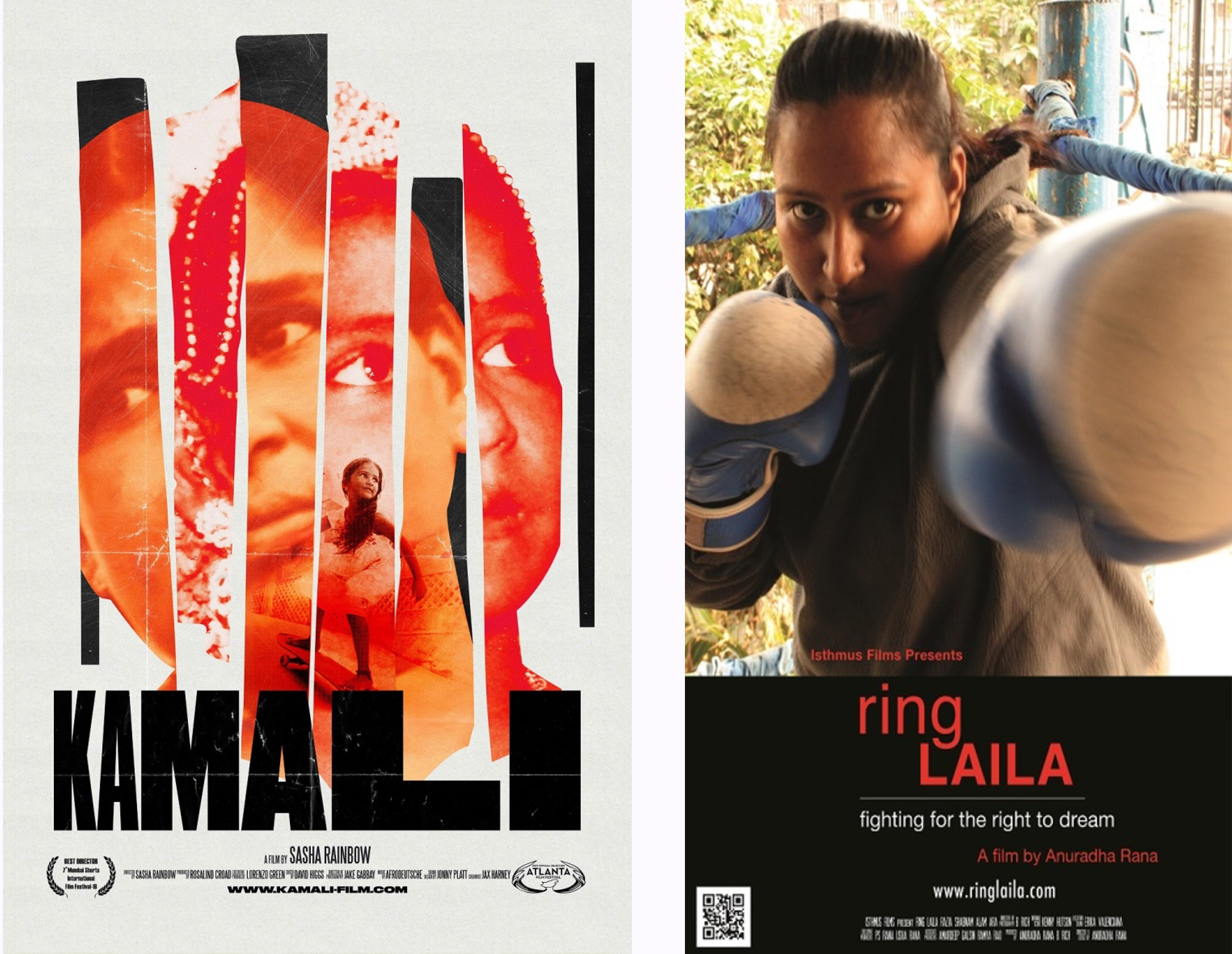
Laila (right) directed by Anuradha Rana. Courtesy: Sasha Rainbow and Anuradha Rana/Isthmus Films
In her series of photographs titled A Sword & A Sari (2017), Nadja Wohlleben, a Germany-based photographer, captures the female martial arts’ grand master Meenakshi Raghavan ‘Gurukkhal’ [Fig. 1]. At the time of the documentation, the seventy-six-year-old protagonist had been training students in the ancient South Indian martial art of Kalaripayattu,[3] of which she has been a practitioner since the age of seven. In her school, ‘Kadathanad Kalari Sangham’, located in the small village of Vatakara in Kerala, Meenakshi teaches fighting techniques and weaponry to around 150 students of all ages and genders. Wohlleben has trained her lens on women as they perform this sword choreography from Kerala. The camera captures the fierceness with which the senior martial artist fights prescribed gender roles in the conservative cultural practice and society in general. Through her choreography, Meenakshi takes on one of the biggest threats women of all ages face in the present: rape. She believes that women need not be ‘passive victims’ but could, through the skills of Kalaripayattu, defend themselves against men who try to take advantage of them.[4]
Sahiba Chawdhary took candid images of North India’s first female autorickshaw driver, Sunita Choudhary [Fig. 3]. Having faced and survived child marriage, marital abuse and the trials of obtaining a commercial driving license, Sunita took to driving her autorickshaw on the streets of Delhi in 2004, as she had ‘no other option but to fight back.’[5] Shot in 2018, the body of work captures the day-to-day life of the driver. Sunita treasures her independence and navigates the streets fearlessly, bonding with her male colleagues and celebrating her trophies and achievements.

Puja Awasthi brought us moments of revelry and energy from Sargam, the all-women’s band of Bihar, as they beat their drums and parade the streets. The ten women are all in their thirties, come from Dhibra village in Danapur, near Patna, and are Dalits. Their band plays with gusto to break not just gender boundaries but also counter caste prejudices. Wearing identically-patterned saris, with sindoor (vermilion) and bindis (ornamental dots) on their foreheads, they celebrate their womanhood as they carry their drums, snare, kettle and bass drum with élan and ease [Fig. 4]. At the gallery, one even got a chance to listen to a recording of them playing, full of vigour and vibrancy.
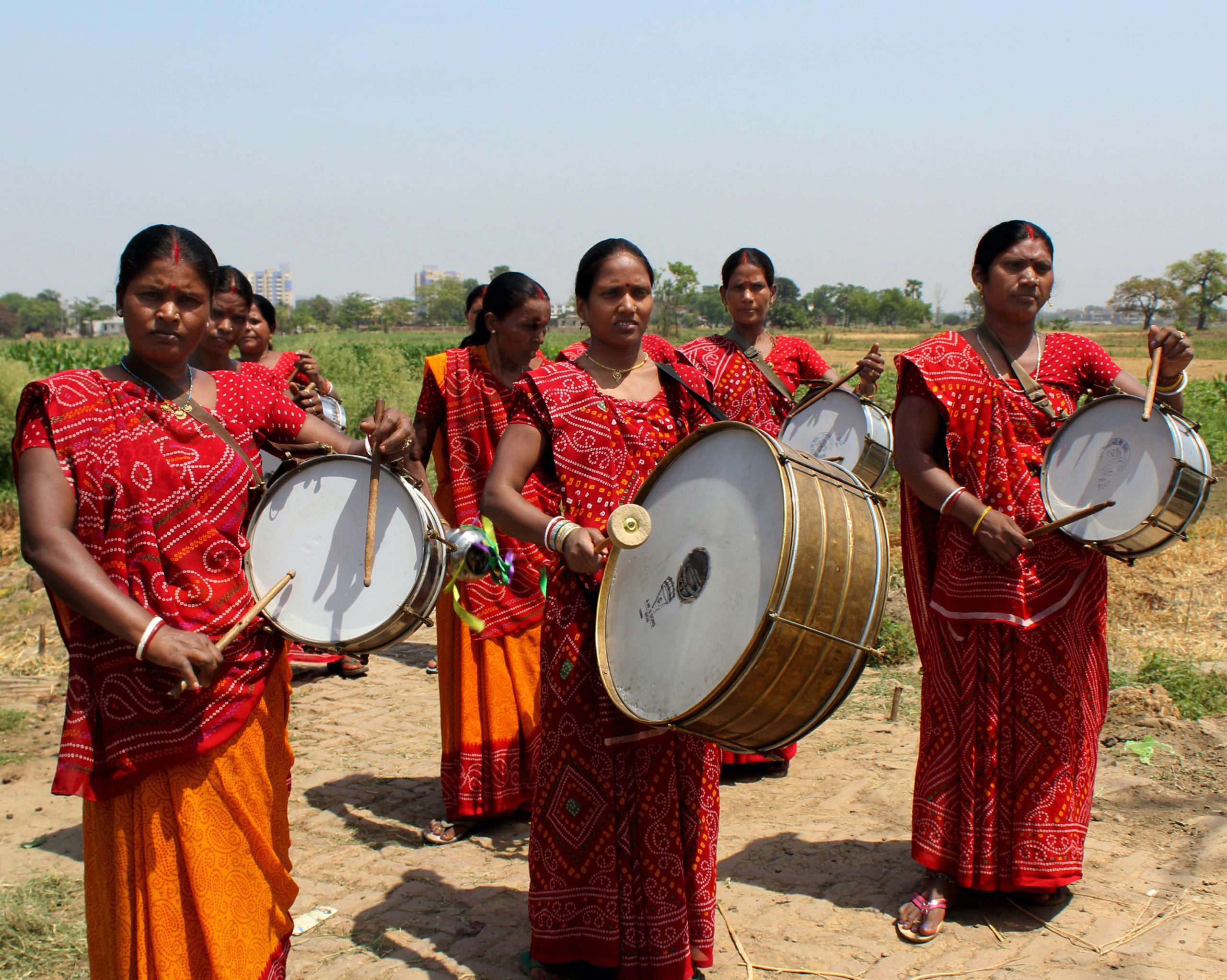
Kolkata-based photojournalist Paromita Chatterjee’s project Dribbling Past Patriarchy [Fig. 5] explores what it means for women to be playing football in a society that continues to constrict them. ‘I started working with an NGO in 2018 that was opening football camps across Bengal to empower the girl child from marginalized sections of the society… It is the search for freedom and self-expression that drives these girls to football,’ says Chatterjee.[6] The extremely empowering feelings arising out of the freedom to kick the ball around in an open field, to score a goal and to express one’s joy are captured by Chatterjee’s camera.

The Yakshagana[7] dancing tradition of Karnataka was previously performed only by males, but now women have also entered the field [Fig. 6]. ‘I travelled to Coastal Karnataka, the home of Yakshagana, to photograph and learn about changing gender representation in this celestial dance form,’ says Richa Bhavanam. She continues, ‘I was curious to see the form that this young practice is taking, as women are participating as equals in this performing art space that had solely belonged to men for hundreds of years.’[8] The women look powerful and embody an androgynous energy that brought to the performance space the power of the Ardhanarishvara, a composite of Lord Shiva and his consort Parvati.[9]
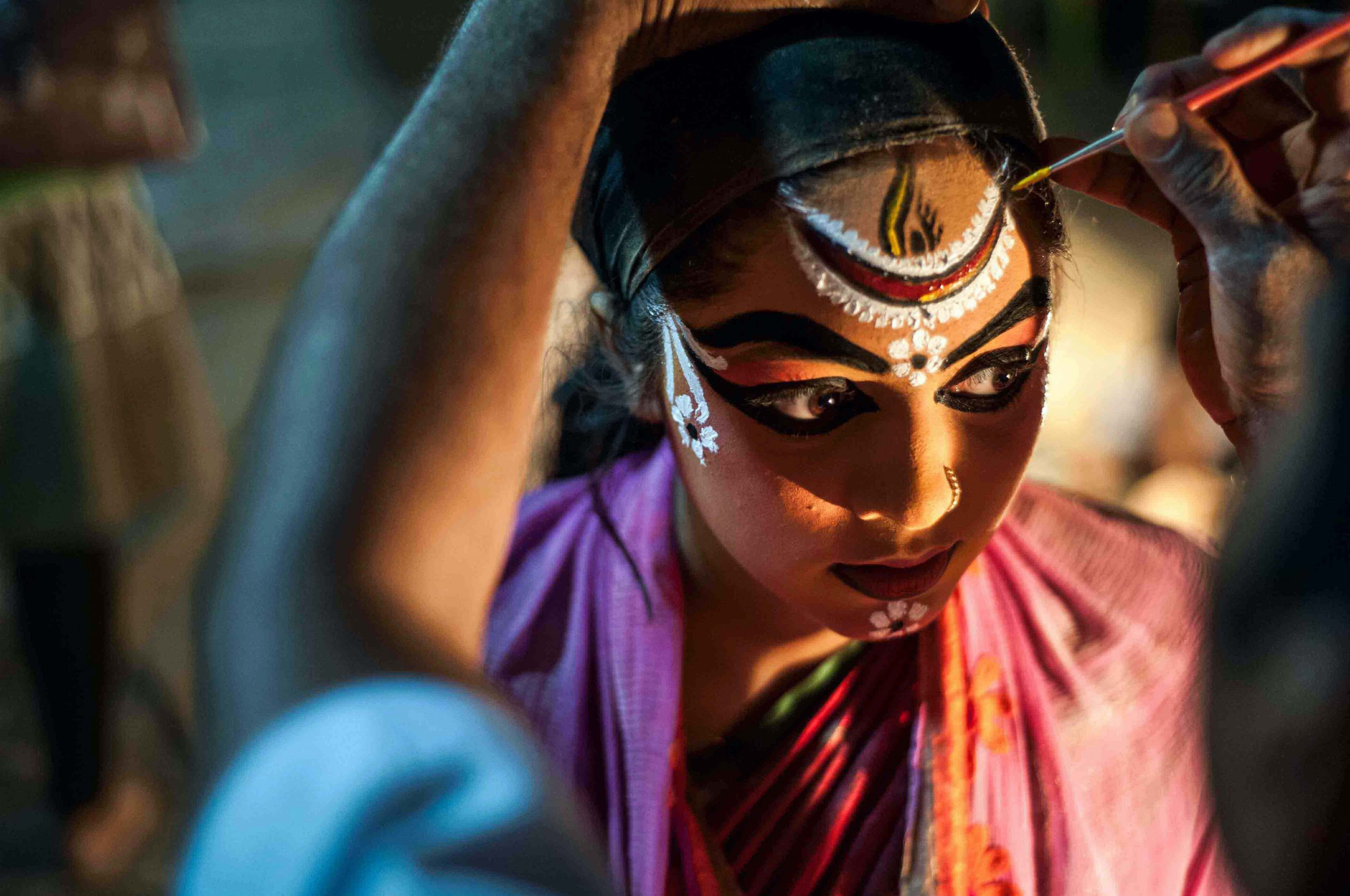
In the archival images of the Gulabi Gang, a group of women are dressed in gulabi (rose pink) saris as they protest, march, gather and make their voice and presence heard and felt [Fig. 7]. In 2006, Sampat Pal Devi started the Gang in response to rampant domestic violence and social injustice in the Banda district of the Bundelkhand region.[10] Known as the underbelly of Uttar Pradesh, it is one of the poorest 200 districts in India. Over the past decade and a half, Sampat Pal Devi has single-handedly helped the women within the community defend themselves against forms of sexual violence and mobilize around establishing the relevance of education and women’s empowerment as well as combating oppression and corrupt practices.
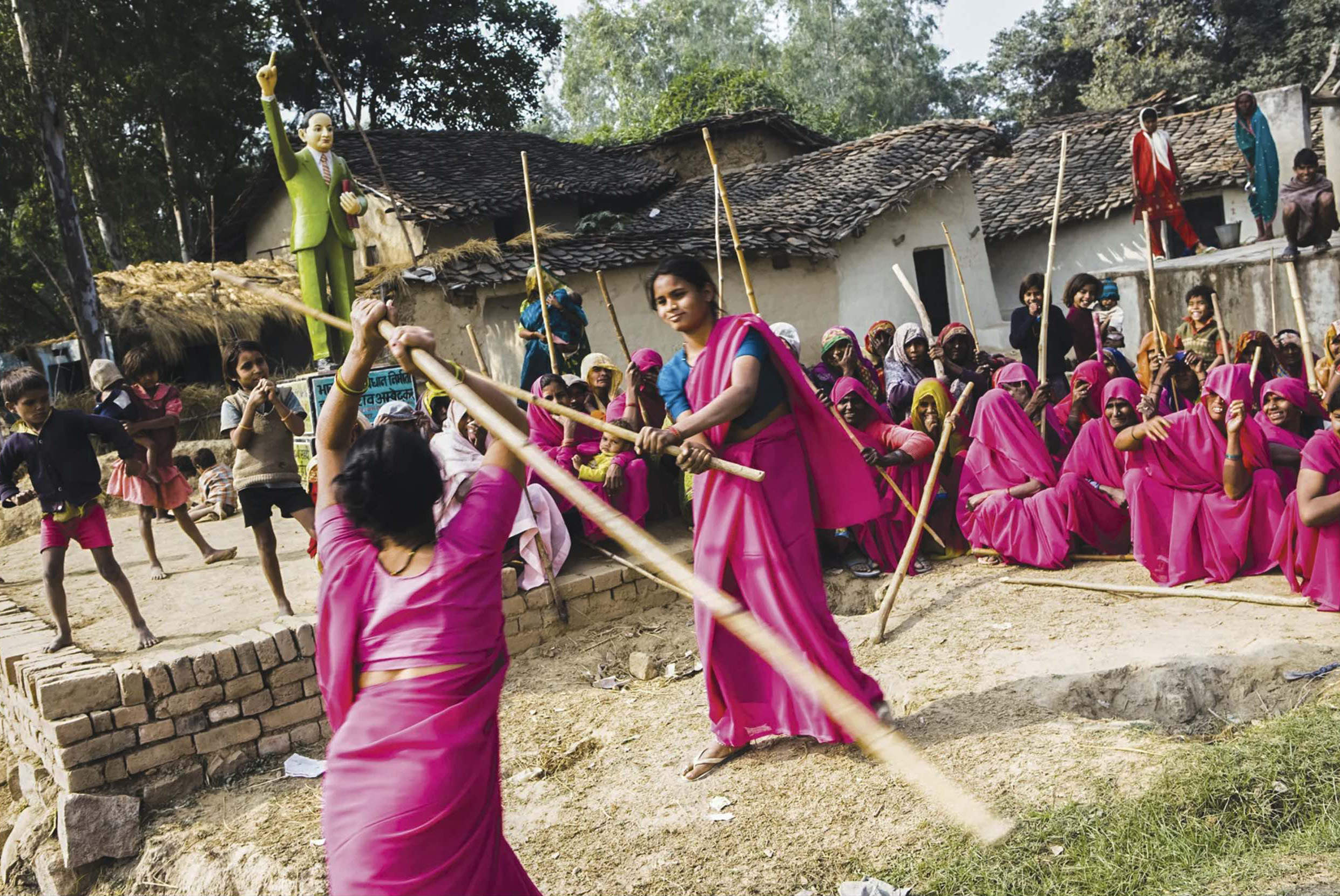
The still and moving images on display depict a new modern era of gender egalitarianism and societal evolution as a much-desired human goal. Biswas said, ‘These are a few success stories of this handful of individuals who gathered immense strength and courage to fight, break out, and create a change within their lives in a strongly conventional patriarchal society. The culmination of photographs, films and multimedia helped give the exhibition a new dimension and make it more versatile.’
Using both archival material as well as contemporary photographs, Biswas’ focus on intersectionality and gender equality in the fields of livelihood, sport, performance, women’s mobilization, etc. is convincing and educative. Exposing some difficult truths of Indian life that render women’s contribution to the growth of the country and its economy unrecorded and invisible, Truth or Dare records the struggles of women across India, showcasing their varying triumphs over patriarchy.
Notes
- Sandeep Biswas, Curatorial Note for Truth or Dare, April 2023. https://www.studioartgallery.in/exhibitions/14-truth-or-dare-curated-by-sandeep-biswas/overview/.
- A Diminishing Line (2022), curated by Sandeep Biswas, was an online exhibition hosted by the VASA Project. It featured the works of four women photographers from India, namely Richa Bhavanam, Paromita Chatterjee, Ruhani Kaur and Uzma Mohsin. See: https://vasa-project.com/gallery/kaur/index.php.
- Kalaripayattu is considered one of the oldest martial arts in the world. Originating in Kerala, it has close ties to Hinduism and its ritual philosophies. It consists of a holistic system of combat as it includes hand fighting, yoga, choreographed sparring with swords as well as healing methods. Notably, it has always been taught to both men and women.
- Nadja Wohlleben, A Sword & A Sari (2017), https://www.nadjawohlleben.com/a-sword-a-sari.
- Sahiba Chawdhary, North India’s First Woman Autorickshaw Driver (2018), https://www.sahibachawdhary.com/stories2/north-indias-first-woman-auto-rickshaw-driver.
- Paromita Chatterjee, Dribbling Past Patriarchy (2018), https://www.paromitachatterjee.com/womenfootball.
- Yakshagana is a dance drama form associated with Karnataka that originated between the eleventh and sixteenth centuries. All-male troupes traditionally performed stories from Hindu mythology and epics all through the night in the open air for the community.
- Richa Bhavanam, Mahila Yakshagana: Where Women Become Heroes (2018), https://richabhavanam.myportfolio.com/documentary-1.
- Aardhnarishvara (literally half female god) is a popular iconographic form of Shiva, in which the god is portrayed as a composite body that is half-male and half-female. The figure is seen as a synthesis of masculine and feminine energies, represented by Shiva on the right, and his consort, Parvati, or Shakti, on the left.
- Gulabi Gang website, “History”, https://gulabigang.in/history.php
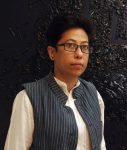 Georgina Maddox is an independent critic-curator with 20 years of experience in the fields of Indian art and culture. She blurs the lines between documentation, theory and praxis by operating as a critic/curator. She was a full-time journalist working with Indian Express, Times of India and India Today. Subsequently, she has engaged in the act of curating, collaborating and writing about art practices that examine and speak about issues of gender/sexuality/marginalization and the juxtaposition of social hierarchy with acts of agency and defiance.
Georgina Maddox is an independent critic-curator with 20 years of experience in the fields of Indian art and culture. She blurs the lines between documentation, theory and praxis by operating as a critic/curator. She was a full-time journalist working with Indian Express, Times of India and India Today. Subsequently, she has engaged in the act of curating, collaborating and writing about art practices that examine and speak about issues of gender/sexuality/marginalization and the juxtaposition of social hierarchy with acts of agency and defiance.
She has critical essays in books like Articulating Resistance: Art and Activism; edited by Deeptha Achar and Shivaji K. Panikkar, and The Phobic and Erotic, edited by Brinda Bose and Subhabrata Bhattacharyya. Currently, she writes for various publications, like the Hindu, MASH Magazine, Studio International, STIR World, Take on Art and Art Amour. She has also contributed to Harper’s Bazaar, Vogue, Elle Magazine and Open Magazine.